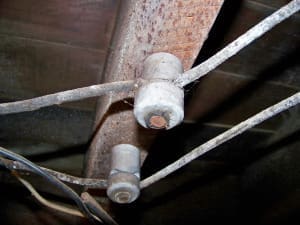At the Christine Cowern Team, we’re always running into homes that have knob and tube wiring. Whether it’s in one outlet only or the majority of the house. Sometimes it’s abandoned (or disconnected) and other time’s it’s live. When buying a home in Toronto, finding this type of older wiring is common! We’re here to debunk some myths and make the words ‘knob and tube’ a little less scary for you!
What You Need To Know
Knob and tube wiring was the electrical system that was used in the first half of the 1900’s, from the 1900 – 1950’s, and it consists of two wires, live and neutral (no ground). Insulator knobs were used to keep the wires isolated and ceramic tubes were used to line the holes through the wooden joists or studs.
Insurance companies have deemed this style of wiring to be unsafe and a fire hazard because if it was installed poorly or has been damaged there’s a greater chance that the wires will short circuit and overheat. However, according to the Electrical Safety Authority (ESA), knob and tube wiring can be safe & functional and in many ways is not inferior to modern wiring.
Unfortunately, when purchasing a home in Toronto, most insurance companies will not give you insurance if your new home contains knob and tube wiring, however, there are companies who will still provide this insurance if the amount of the knob and tube wiring is under a certain percentage, although they’re harder to find. Just make sure that you contact your insurance company to ensure that they’ll cover you before firming up on any purchase agreement. And how much will this cost? You should anticipate paying $800 to $1,000 per room to remove knob and tube.
Here are some of the main myths and facts from the ESA about knob and tube wiring:
Myths
– Knob and tube is an unsafe type of wiring
– The Ontario Electrical Safety Code no longer recognizes knob and tube wiring as an acceptable wiring method.
– All knob and tube must be disconnected and replaced
Facts
– Knob and tube wiring is safe, provided it is properly maintained by a competent licensed electrician
– The ESA as well as the Ontario Electrical Safety Code recognize and accept knob and tube wiring methods
– The Ontario Electrical Safety Code edition contains rules that govern the installation of open type wiring methods (knob and tube). Rules 12-200 to 12-224 set out the minimum safety standards for the installation of open wiring, which may still be installed to this day
Are you thinking of buying a home and have a knob and tube wiring questions? Are you worried that your current home may have knob and tube wiring and how this could affect your sale? Just give us a call at #416-291-7372 and we can answer all of your questions.


